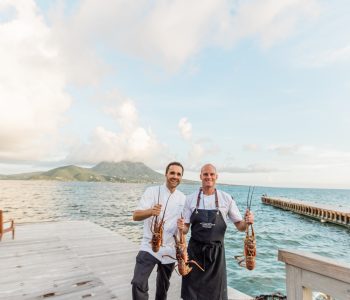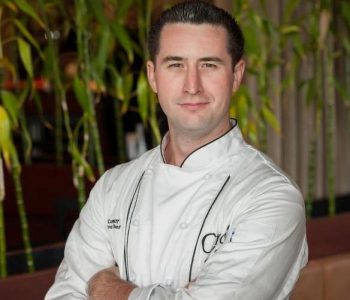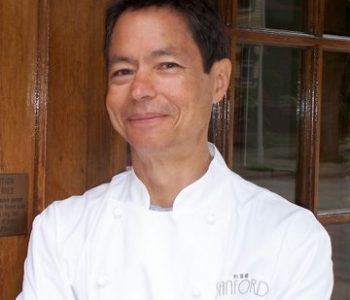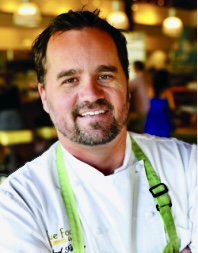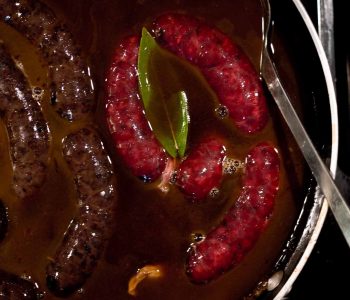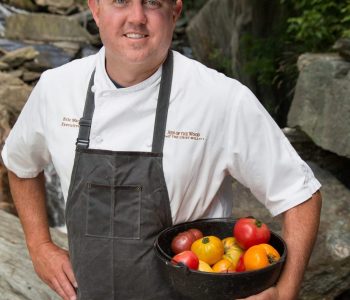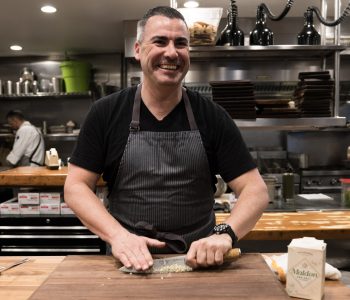
Chefs Coast-to-Coast – Featuring David Guas, Executive Chef, Bayou Bakery — Arlington, Virginia
Bee Obsessive — Chef David Guas rolls out his love of honey and parts with the hibiscus-ginger-honey ice tea formula!
David Guas is chef and owner of Bayou Bakery and DamGoodSweet Consulting Group in Arlington, Virginia. He is the author of the cookbook DamGoodSweet:Desserts to Satisfy Your Sweet Tooth New Orleans Style (see review in an earlier post).
I encourage chef Guas to set the stage for the “all things honey” train ride we’re about to take. Making the journey even more gratifying, we’re packing his caramel popcorn for this journey.
“For me, being a chef is not just cooking and picking out good produce, but it’s the full circle of knowing where things come from and who they come from. We know carrots come from the ground, we’ve moved past the fact that they don’t grow in a grocery store. And now it’s who picked these, and who planted the seeds, and how many people does this support when I buy this carrot. It’s about relationships. If you have a farmer you can trust to deliver quality, that’s what you fall in love with initially. You realize whom you’re supporting when you pick up the phone once a week and order twenty-five pounds of carrots. It’s not just a robotic email transmission and you get your product tomorrow kind of thing. At my restaurant we put up the photographs of our vendors that grow our peaches and harvest our honey. That way, people can see whom they’re supporting when they buy the product from Bayou Bakery.”
Tell me the honey tale.
David Guas: My interest in honey: where it comes from, how it’s cultivated and harvested, and sort of going a little deeper and peeking around the curtain kind of thing, has been ongoing for the past nine years. I ended up asking those beekeepers that I purchased my honey from if they minded some free labor. That always goes over quite well, because who doesn’t love free labor.
In other words you wanted to learn what they’re doing and how they’re doing it.
David Guas: Yes. I’ve tagged along numerous times with different beekeepers to tend their hives during harvest time. It’s either the Shenandoah, Virginia area, or I travel about two hours northeast towards Greencastle, Pennsylvania. I connected with beekeeper, Jeff Stoner of Stoner Apiaries because of my relationship with our goat cheese guy. Our goat farmer, Brad Parker, has a place called Pipe Dreams Farm. He studied cheese making right out of college at a small farm in Leone, France. Brad, originally from Pennsylvania, returned and started his farm. He delivers goat cheese to the DC area every Thursday for the past 13 years. We started talking and I asked about honey: he said, “Oh yeah I’ve got this guy and blah, blah, blah.”
Jeff Stoner has five hundred hives that he spreads across three different counties. He’s a Mennonite. He’s got seven or eight kids, they’re all homeschooled and I could tell initially he was extremely hesitant to let me into his world, but he decided to do it for whatever reason. Maybe he felt I was likeable or trustworthy. He invited me down to his place and we didn’t extract at the time, we just treated the hives for mites. It was the hottest October in history. There I stood in 90 plus degree weather in full suit and veil, trying to hit all the hives to treat them for mites, in addition to feeding them with heavy syrup that Jeff makes to prepare them for winter. It took ten-and-a-half hours, very much like the restaurant industry, except that Jeff was doing it all by himself.
Your seem to have a stable of free-spirited artisans and purveyors.
David Guas: Indeed. That’s one of the reasons why I think they’re so attractive to me. Everybody has a story just like I do. And I envy what they do and they envy what I do, and without each other we don’t have much of a career. And at the same time, it can cause headaches and frustration. These farmers one of them, Brad Parker decides he’s going on a two-week vacation and doesn’t give his clients a heads up.
David, they’re artists in their own right.
David Guas: Trust me, I know. Going back to honey, I have about 60 different varietals at my house. Now that the word is out that I am fascinated with honey and I collect; people collect for me. I receive random gifts: “I was in the Rocky Mountains and I saw this and I thought of you and, boom.
So I’m not cooking with honey at home as much because I’m cooking with it at the restaurant. My youngest had a biscuit today with honey and a little bit of butter and he picked out his own honey. Today, he used a blackberry honey that came from Tennessee.
What do all your beekeepers think of what’s going on with the bee mortality rate?
David Guas: Most of the guys that I purchase from, and know personally, are not experiencing anything outside of the norm for mortality rates at the end of the year. It’s a regional thing. Maybe a lot of people have seen things happen in the US in big numbers in certain parts of the country, but other parts of the country have experienced zero massive collapses in the colonies.
It makes you wonder.
David Guas: I did a PBS documentary with a local production company titled “Disappearing Act: A World Without Bees.” We worked with Whole Foods and attempted to show the weight of what would happen if these creatures, these insects were wiped off the planet. David Hackenberg, who I did the documentary with, and is credited with raising the flag and creating the name Colony Collapse Disorder, CCD. Now, of course, the Honey Board doesn’t want us to talk about the subject and I can appreciate that because they’re a marketing department, they want to spread the positive message that honey is a fantastic, all natural product. They’re not at the point where they want to recognize a disorder that we don’t know enough about.
I’ve done a lot of work with the National Honey Board based out of Denver. They’ve actually hired me. I’m, apparently the national chef spokesperson for honey. I’m the honey guy. I’ve traveled with them to speak to large groups in Knoxville, New York, and the CIA at Greystone in Napa. In 2010, they experienced a 15 percent increase in honey production. So you wonder about the CCD, the Colony Collapse Disorder.
I don’t really lend my opinion on it because I’m not a beekeeper so I’ve never experienced the full loss of an entire colony. If people that want to know more about CCD they should research it on the Internet and there are a lot of documentaries out there. There’s one called the Vanishing of the Bees and UC-Davis and Penn State are the two major universities that have been the headquarters for a lot of this research for CCD.
How do you use honey in your cooking?
David Guas: There are not many things like honey that you can talk about that we use on a regular basis in our kitchens at home or in our professional kitchens. You flip the bottle over and it has one ingredient, and it’s honey. And then there is the dessert end of it; it’s sort of a natural inverted sugar. It makes wonderful creamy smooth ice creams and it gives a wonderful, soft mouth feel to a lot of different things. Parfaits and semifreddo’s, things that would be frozen, I think they lend very nicely to that.
Three different things that the honey can do: create a textural product that’s unique to itself, bring in a specific flavor, and add sweetness.
Honey in recipes and what it can do for high acid foods such as vinaigrettes and tomato based products, is just balance. It’s a perfect way to balance things. So if you feel like something is a too sharp or acidic, try a tablespoon of honey before you go to something else, or try to balance it with something that is naturally sweet like red bell peppers.I gravitate to fruits that are naturally floral like oranges. When you start cutting them open their perfume permeates the room. I often go to something as simple as the orange with honey and even grapefruits with honey, especially for making beverages.
We do a tea here in the restaurant. It’s a hibiscus-ginger-honey ice tea. We steep the dried hibiscus blossoms, make a ginger syrup with ginger root, sugar, and water, and then we take Jeff Stoner’s honey and sweeten the batch. You’ve got the mouth feel and the sweetness from the honey and a little bit from the syrup as well, the spiciness of the ginger, and then the earthiness of the tea from the hibiscus blossom. It’s a huge hit. We’ve sold hundreds of gallons of it since we launched it.
What savory dishes might you use honey in?
David Guas: I use it in brines. I use it in glazes for poultry — rosemary and honey with a little bit of limejuice. You know you just take honey and chopped fresh rosemary, add a little bit of lemon juice and brush that
on different guinea hens and small birds, or duck. I tell people to put things on the grill or baste them using honey with water or chicken stock and just keep basting the top of your birds. It’s going to produce a caramelized skin that you won’t believe. So it’s sort of endless. I use it a lot in barbecu sauces here at the restaurant.
You call your food elegant comfort food, which is not a really common term — definitely comfort food — but how do you view it as having elegance?
David Guas: I think the refined aspect is that the food is thought through. I have created all our sandwiches based on a specific flavor profile, or maybe a sandwich that I grew up with in New Orleans, and so forth. It may be something you recognize from your childhood if you’re from Texas, Birmingham, or Blackmans Parish, Louisiana. I mean there is something for everybody here.
Your grandfather was Cuban. Does that influence the food?
David Guas:I don’t know where it directly affects or influences my cooking. I don’t really use a lot of Caribbean flavors, but at the same time, a lot of Louisiana cuisine is from the Creoles, Spanish, African, and the French.
Growing up in New Orleans and having a Cuban father — we cooked the traditional Cuban dishes at home — black beans and rice, green plantains that we would smash and fry with salt. Every savory dish would have the sweet plantains on the side. I knew how to cook those dishes at a fairly young age. We’d always have some type of pork dish. My dad would marinate a pork loin or a pork butt with garlic, limejuice, dried oregano or cilantro, a lot of garlic, and black pepper.
You’re so known for your sweets. Is that your perception of yourself, or do you feel that you’re very well rounded?
David Guas: Well, I think I’m very well rounded. I think that for the first time I’m able to show my skills and have my own place. And I don’t want to be known as just the dessert guy.
Having a breakfast, lunch, and dinner establishment where 98.5 percent of what we serve is made in-house and from scratch is very satisfying. We do our own bread and butter pickles. We make our own pepper jelly. We make our own fruit jams. We put all that out complimentary. It’s nice to say, “We do it all here and under my direction. My recipes, my formulas, my flavor profiles, my history, my family, my everything.” If I were to do a savory cookbook, it would be very much…
Would you ever do one?
David Guas: Of course.
I can’t end without asking why your deviled eggs are so special? They’ve been written up in the Washingtonian.
David Guas: Deviled eggs can be sweetly weird — Miracle Whip and pickle relish and all the different variations in between. I use Dijon mustard, mayonnaise, hot sauce, cayenne pepper, and salt — whip it up so it’s really, airy, and then push it through a mesh tami to make a smooth creamy filling. I put the filling in a piping bag and pipe them to order, finishing off with a little Creole seasoning.
David’s Recipe>>
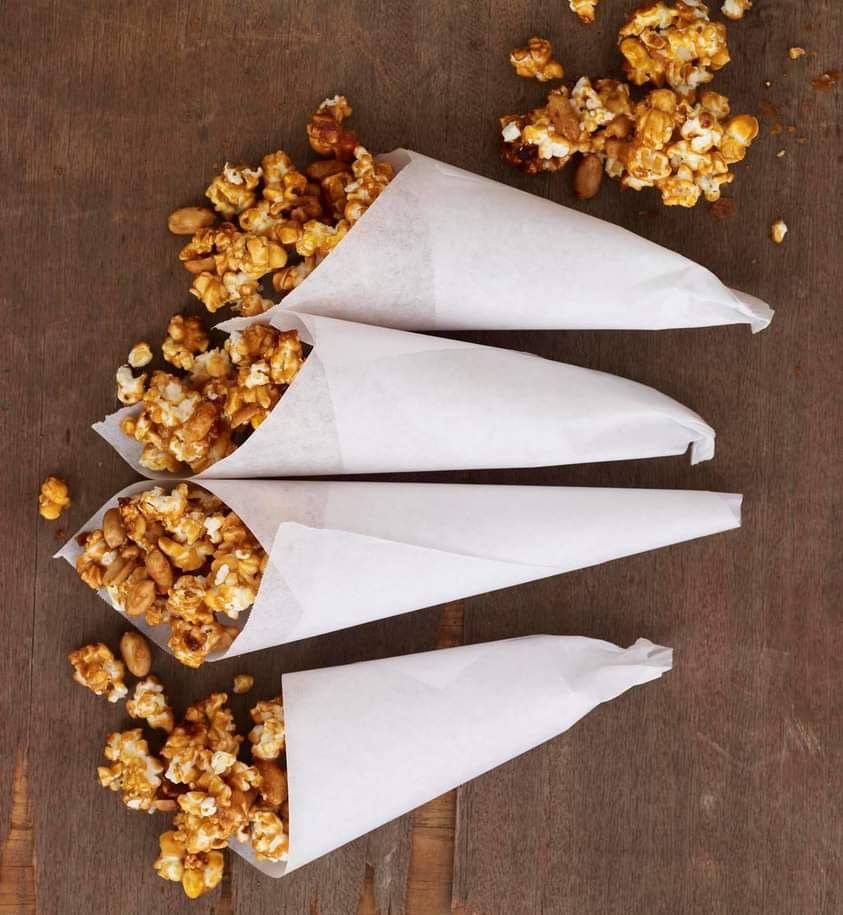
CARAMEL ALMOND POPCORN
Makes about 10 cups
Ingredients
1 (3½ -ounce) bag plain (unbuttered natural flavor) microwave popcorn
1 cup packed light brown sugar
¼ cup light corn syrup
6 tablespoons unsalted butter, melted
1 teaspoon salt (kosher)
2 tablespoons hot water
1 teaspoon vanilla extract
½ teaspoon baking soda
¾ cup of sliced almonds, toasted (325°F for 16 minutes)
Directions
Pre-heat oven to 250˚F. Line a rimmed baking sheet with parchment paper and set aside.
Pop the popcorn according to the package instructions.
Lightly spray the inside of a large mixing bowl with nonstick cooking spray and add transfer the popcorn from the bag to the bowl, and reserve. Chef’s Note: Remove any unpopped kernels of corn before step #4.
Whisk the sugar, corn syrup, butter, salt and water in a 2-quart saucepot and bring to a simmer over medium-high heat, stirring often, until the mixture reaches 250˚F on a candy thermometer, 3-4 minutes.
Remove from heat and whisk in the vanilla and the baking soda.
Immediately pour the hot mixture over the reserved popcorn and using a rubber spatula, gently fold the caramel into the popcorn until it is completely coated.
Sprinkle in the toasted almonds and gently fold a couple more times to distribute them.
Transfer the mixture to the prepared baking sheet.
Bake in the oven for 1 hour, stirring every 15 minutes. Remove from oven and allow the popcorn to cool for 20 to 30 minutes. Gently break up the popcorn and serve, or store in an airtight container until ready to serve or package for gifts. Chefs Note: The sealed popcorn will keep for approximately 1 week depending on the container and the humidity level outside.
Find out more about David Guas @ bayoubakeryva.com

